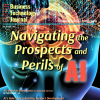Business Transformation Requires Transformational Leaders
Leadership and teaming skills are front and center in times of rapid change. Meet today’s constant disruption head on with expert guidance in leadership, business strategy, transformation, and innovation. Whether the disruption du jour is a digitally-driven upending of traditional business models, the pandemic-driven end to business as usual, or the change-driven challenge of staffing that meets your transformation plans — you’ll be prepared with cutting edge techniques and expert knowledge that enable strategic leadership.
Subscribe to Arthur D. Little's Culture & Leadership Newsletter
Insight
If the ultimate goal of artificial intelligence (AI) is to efficiently replicate and exceed human thought for the good of humanity, then building trust requires that AI incorporate the multitude of sound human decision capabilities. Just reading this statement makes it clear that the journey toward AI ethics is no easy road.

















